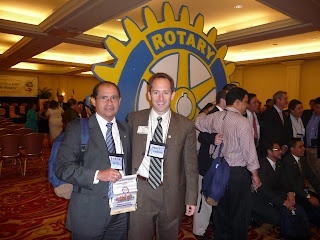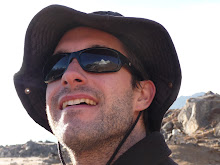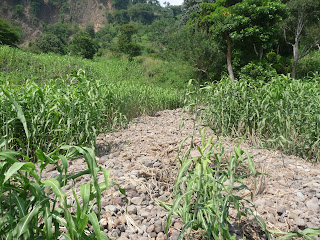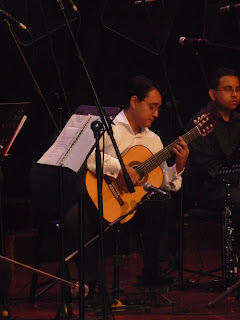Backpacks
An important annual campaign for the club is to provide backpacks full of supplies to needy children in the area. The backpacks cost $7/each and last year the club raised money for 20,000 backpacks. Some of the money comes from companies and organizations whose logos are then printed on the bags and the rest from philanthropic individuals. Rotarians and children alike light up when the bags are delivered. This year’s campaign has been much more difficult due to the economic crisis, but the club is still shooting for 15,000 backpacks. I facilitated a donation for my sponsor club in Hamden to take part in the campaign.
Advertisement for the backpack campaign - it helps when your President runs a print shop!
President Carlos Pocosangre kicks off event to thank last year's big givers
Presenting an award to one of last year's most generous givers
Award
Honoring Local Heroes
I also had the opportunity to attend a really well produced awards ceremony honoring El Salvadorans who have made a difference in their fields. One of the club members is a producer for one of the country’s main TV stations and he put together professional videos highlighting the efforts of each award winner. It was literally like watching the Oscar’s. Awards were given in the areas of human rights, the environment, the arts, and sports. (Unfortunately I forgot my camera that night.) Voices de Rotary
Perhaps the event that impressed me most – which actually happened in April before my time – was a “Voices of Rotary” concert. In the early days of Rotary, founder Paul Harris and his friends used to sing as part of their regular meetings, which rotated among the homes of the members (thus spawning the name “Rotary”). Channeling this bit of history, Club Cuscatlán organized an impressive concert at the National Theatre with orchestras, ballet dancers and more. Every song featured a singer and every singer was a Rotarian. Some were famous names, others just average folks with a gift and some courage. Rotary sold 1,200 tickets and raised tens of thousands of dollars for local causes. I bought the DVD (also a fundraiser) and will be happy to show it off when I get home.
Social Events
The members of my host club also have developed wonderful friendships –as is common in Rotary – and they generously welcomed me into their family. On a number of occasions I joined Rotarians for lunch, dinner or drinks. On one particular occasion, I was invited to the going-away party for one of the club’s long-standing members.
National Conference
Finally, my sponsor club organized this year’s National Rotary Conference Nov 13-14. It was largely a social event with the chance for all the clubs in El Salvador to get together, network, celebrate, and do some strategizing. It was held at the Real Intercontinental, the same hotel where I attended the microfinance conference (see blog titled: “Microfinance Conference”).
The event kicked off Friday late afternoon with the Air Force Band playing a range of rousing tunes including the theme song from Star Wars. After the current Governor of Rotary District #4240 (covering El Salvador, Honduras, Nicaragua and Costa Rica) officially inaugurated the event, the band played the Costa Rican and El Salvadoran National Anthems.

Air Force Band

Club Cuscatlan kicks off the 2009 National Conference

District #4240 Governor inaugurates the conference
That was followed up by a nice evening of socializing, where I got to visit with members from all of the clubs I had spoken to over the course of my scholarship period.



Saturday was a full day and chock full of great speakers and presentations. A particular moving portion was a video shot by a fellow member of Club Cuscatlán on his visit to the disaster areas. I have posted a copy of it in the blog about Rotary’s humanitarian work post-hurricane. Another highlight was a presentation by Rodrigo Davila, a member of another San Salvador Club and renowned motivational speaker. He has two best-selling books and is a really great orator. I am sometimes skeptical of motivational speakers, but Rodrigo’s enthusiasm and delivery reminded me of why they can be so popular. He had a room full of adults dancing joyfully around like school-children by the end. Quite impressive. Rodrigo also joined us in the trip to deliver provisions to Paraiso.

Rodrigo Davila

Are you feeling motivated?
Next, there was some time set aside for breakout sessions. One of Rotary International’s goals for the year is to promote greater coordination and collaboration among clubs. I joined in with the emergency response committee. One great result was the resulting coordination between the San Salvador clubs to pool their resources and organize three helicopter deliveries last week.

Emergency response team
During dinner I was unexpectedly invited up to the podium and given a nice send-off by the President of Club Cuscatlán Carlos Pocosangre. He also game a warm thank you to the Hamden Club for their donations. I was invited to give a few words and I thanked all of the clubs for their kindness and hospitality, and for working so hard to improve communities in El Salvador and around the world. Of course, I also thanked them for supporting programs like my scholarship. My host club then presented me with their club polo shirt which I wore to last week’s trip to deliver humanitarian aid.



The conference ended with a night of dancing and celebration. I will sincerely miss the Rotarians from El Salvador, particularly the members of Club Cuscatlán.










































